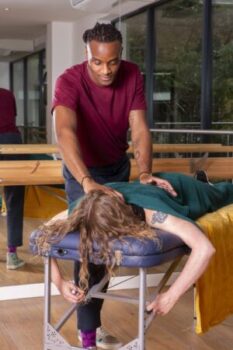Anatomy in Motion (AiM)
A post-graduate course I studied with Gary Ward, founder of Anatomy in Motion and author of “What The Foot?”.
AiM is based on the premise that gait (aka walking) uses every joint in the body in all three dimensions. By analysing gait and its component motions, I can address non-optimal movement at both a global (full body) and focal (individual joints) level.
What is Anatomy in Motion?
Anatomy in motion, also known as AiM, is a way of looking at the human body. It was developed by Gary Ward, author of ‘What the Foot?’. The philosophy is not a technique but a way to track movement through the human gait cycle (walking). With this ‘map’ of human movement we are able to see what every joint is doing through the gait cycle. We can look at chronic pain in a new light. We can connect the whole body from your foot to your skull and spot movement compensations—perhaps a millimetre here or there—that spiral upwards or downwards and cause pain and dysfunction.
How many times have you stretched the same muscle, foam-rolled the same spot, and had your osteopath or chiropractor perform high velocity manipulation? The pain dissipates for a couple of days but returns. There is a reason why the same spot keeps bothering you. It could be that something higher or lower in your body needs to be addressed to help clear this issue up for good.
Anatomy in Motion specifically asks the following questions:
- How have you set yourself up in three dimensions?
- Is each joint within the body able to move freely in the sagittal, frontal and transverse planes?
- Where is your centre of mass resting?
- What movements are missing?
- Challenge your body’s position by encouraging it to rediscover those missing movements.

The Gait Cycle
Gary Ward created the Flow Motion Model™, which is a map of the moving human body and the journey your body takes through the gait cycle. He recognised that when the heel hits the ground it’s possible to determine what each joint in the body is doing in all three dimensions at that particular moment in time. He identified five key phases of walking as we roll from heel to toe, covering a journey of 0.65-0.8 seconds in which every single joint undertakes every single possible motion in all three dimensions!
Here’s what you should know about Anatomy in Motion
1. What you should know about the movement
During all movement, the joints, ligaments and muscles in your body have a role to play and everything is dependent on all other parts being capable of doing their job in order to function optimally. When your body reduces movement to protect something, due to previous injury for example, it exposes other areas which can become at risk—this may or may not be at the site of pain.
2. How this is done
The majority of health practitioners concentrate on stabilising structures and getting patients strong by working glutes and using a foam roller and bands. I recognize that movement is ever present in the system, so why stabilise what should be taught how to move? All joints move in harmony with each other, but they somehow lose their way over the years, due to the trauma you have put your body through over the years.
Regardless of your discomfort, our goal is to teach your body to find its centre by following the map of the Flow Motion Model. A centred and balanced body is one in which the human body holds the richest environment for your healing to take place.
3. Here’s what happens during a session
The Anatomy in Motion process usually starts with the feet. During a session we check how your feet, pelvis, ribcage, skull, and everything that attaches to them, move together in three dimensions. We check your static and dynamic postures; using this process we have been able to eliminate patients’ painful conditions from the head to the feet.
This is another way to view the body and get a hypothesis for what is driving your symptoms, from lower back pain, sore calf muscle, or plantar fascia issues to headaches and those stubborn patella tendons and achilles issues which have not resolved completely for years.
If you would like to get started to really find out what is driving your painful issues, get in contact with a movement physiotherapist, feel free send me an enquiry below.
How AiM Promotes Healing
AIM helps you become more aware of your everyday movement patterns, identifying inefficient motor methods and dangerous postures. AIM’s purpose is to provide your joints equitable access to every point in all three planes of human mobility, allowing each joint to move freely toward its full range of motion. Repetitive motion from sports, exercise, and daily activities knocks your body off balance, making symmetrical movement impossible. We soon begin to “own” our limits, announcing to the world that we have a damaged knee or back.
Ready To Book?
If you’re ready to book your appointment, simply click the button below, if you have any questions you’d like to ask before booking please contact me by phone on +44 7539 107940 or email me at kevin@kevinpowellphysio.co.uk.
Physiotherapy Services
PRE & POST PREGNANCY
See how I can make your pregnancy journey easier and why it’s so important to consider individual medical history and past musculoskeletal injuries.
ANATOMY IN MOTION
Improve your posture and balance by tracking your movement using Anatomy in Motion activities. It shows you how your feet influence your whole posture and movement.
CRANIOSACRAL THERAPY
Crainiosacral therapy is a gentle, hands-on method that helps realign the body tissues, the bones, fascia, and muscles, therefore helping your body to heal.
Physiotherapy Services
View More >>
Read Here To Know How Physiotherapy Can Help You
Enquire today!
Please fill out the form below, and I will get back to you as soon as possible.



